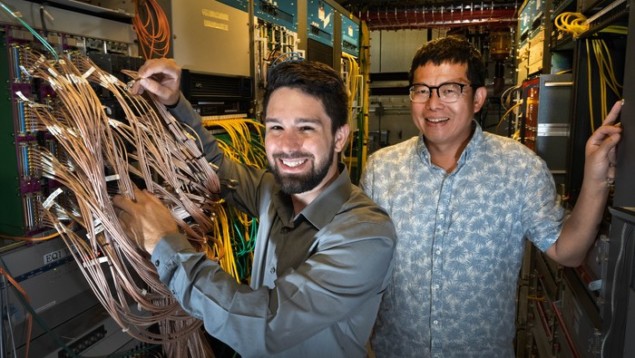
Using quantum entanglement, physicists in the US have mapped out distributions of gluons within atomic nuclei at higher precision than previously possible. Physicists working on the STAR experiment at Brookhaven National Laboratory (BNL) made their measurements by using an interference effect related to the quantum entanglement of the oppositely charged pions created when high-energy gold nuclei pass very close to each other.
According to the theory of quantum chromodynamics, gluons are mediators of the strong nuclear force. This is the interaction that binds quarks inside protons and neutrons, and also holds protons and neutrons together in nuclei. Because of the nature of the strong force, it is very difficult to calculate the properties of even very simple nuclear systems such as individual protons and neutrons. As a result, physicists have a poor understanding of how gluons are distributed in nuclear matter. Now, physicists in the STAR collaboration have improved our understanding by using the quantum entanglement.
The team studied gluon distributions with the help of BNL’s Relativistic Heavy-Ion Collider (RHIC), which accelerates heavy ions (electrically charged nuclei) to close to the speed of light. Recent experiments at the collider had revealed that the speeding nuclei are surrounded by clouds of photons that are linearly polarized in specific directions relative to the nuclei.
Grazing nuclei
Now, the STAR Collaboration has used these photons to probe the gluons within nuclei. This was done by slightly offsetting two opposing beams of gold nuclei so that they do not collide. Instead, the nuclei graze each other by a few nuclear radii.
The polarized photons surrounding a nucleus can briefly fluctuate into quark-antiquark pairs, which can then interact with the gluons in the other nucleus as it passes by. These interactions produce extremely short-lived rho mesons, which rapidly decay into a pair of oppositely charged pions. By observing the trajectories of these pion pairs, the team can calculate the positions of the gluons in the nucleus.
Because a pion pair is created by the decay of a rho meson, the two pions are in a state of quantum-mechanical entanglement and remain so until detected. This results in an interference pattern in the detector that can be related to the polarization of the photon that originally interacted with the gluon. This provides the researchers with additional information about the location of the gluon within the nucleus.

Neutrons fly left or right depending on size of colliding nuclei
Their experiment is somewhat like positron emission tomography (PET), which creates images of the inside of the human body using pairs of gamma-ray photons created by a nuclear decay process.
Using the technique, the team could begin to see the positions of protons and neutrons inside a nucleus by observing the gluon distribution. Their observations matched up with both theoretical predictions of nuclear structure as well as experimental measurements using other techniques. With further refinements of the technique, combined with the next generation of heavy-ion colliders, the STAR collaboration hopes that physicists will be able to create even more detailed images of the interiors of nuclei.
The research is described in Science Advances.



